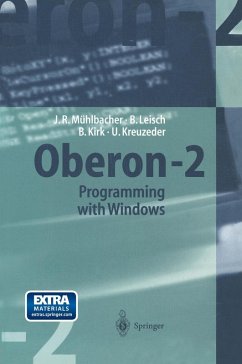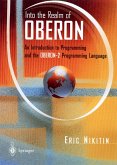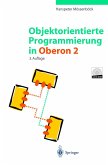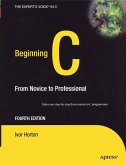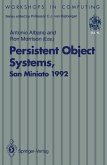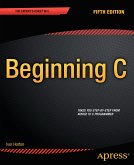Jörg R. Mühlbacher, Bernhard Leisch, Brian Kirk, Ulrich Kreuzeder
Oberon-2 Programming with Windows (eBook, PDF)
72,95 €
72,95 €
inkl. MwSt.
Sofort per Download lieferbar

36 °P sammeln
72,95 €
Als Download kaufen

72,95 €
inkl. MwSt.
Sofort per Download lieferbar

36 °P sammeln
Jetzt verschenken
Alle Infos zum eBook verschenken
72,95 €
inkl. MwSt.
Sofort per Download lieferbar
Alle Infos zum eBook verschenken

36 °P sammeln
Jörg R. Mühlbacher, Bernhard Leisch, Brian Kirk, Ulrich Kreuzeder
Oberon-2 Programming with Windows (eBook, PDF)
- Format: PDF
- Merkliste
- Auf die Merkliste
- Bewerten Bewerten
- Teilen
- Produkt teilen
- Produkterinnerung
- Produkterinnerung

Bitte loggen Sie sich zunächst in Ihr Kundenkonto ein oder registrieren Sie sich bei
bücher.de, um das eBook-Abo tolino select nutzen zu können.
Hier können Sie sich einloggen
Hier können Sie sich einloggen
Sie sind bereits eingeloggt. Klicken Sie auf 2. tolino select Abo, um fortzufahren.

Bitte loggen Sie sich zunächst in Ihr Kundenkonto ein oder registrieren Sie sich bei bücher.de, um das eBook-Abo tolino select nutzen zu können.
Oberon-2 is a successor to the language Pascal, it has quickly become a major language used for teaching purposes. The book is completely self-contained and comes with a full Windows based integrated development environment on CD-ROM. The software is free for educational and private purposes.
- Geräte: PC
- ohne Kopierschutz
- eBook Hilfe
- Größe: 26.82MB
Andere Kunden interessierten sich auch für
![Ivor Horton's Beginning ANSI C++ (eBook, PDF) Ivor Horton's Beginning ANSI C++ (eBook, PDF)]() Ivor HortonIvor Horton's Beginning ANSI C++ (eBook, PDF)43,95 €
Ivor HortonIvor Horton's Beginning ANSI C++ (eBook, PDF)43,95 €![Organization of Programming Languages (eBook, PDF) Organization of Programming Languages (eBook, PDF)]() Bernd TeufelOrganization of Programming Languages (eBook, PDF)40,95 €
Bernd TeufelOrganization of Programming Languages (eBook, PDF)40,95 €![Into the Realm of Oberon (eBook, PDF) Into the Realm of Oberon (eBook, PDF)]() Eric W. NikitinInto the Realm of Oberon (eBook, PDF)40,95 €
Eric W. NikitinInto the Realm of Oberon (eBook, PDF)40,95 €![Objektorientierte Programmierung in Oberon-2 (eBook, PDF) Objektorientierte Programmierung in Oberon-2 (eBook, PDF)]() Hanspeter MössenböckObjektorientierte Programmierung in Oberon-2 (eBook, PDF)51,24 €
Hanspeter MössenböckObjektorientierte Programmierung in Oberon-2 (eBook, PDF)51,24 €![Beginning C (eBook, PDF) Beginning C (eBook, PDF)]() Ivor HortonBeginning C (eBook, PDF)40,95 €
Ivor HortonBeginning C (eBook, PDF)40,95 €![Persistent Object Systems (eBook, PDF) Persistent Object Systems (eBook, PDF)]() Persistent Object Systems (eBook, PDF)40,95 €
Persistent Object Systems (eBook, PDF)40,95 €![Beginning C (eBook, PDF) Beginning C (eBook, PDF)]() Ivor HortonBeginning C (eBook, PDF)47,95 €
Ivor HortonBeginning C (eBook, PDF)47,95 €-
-
-
Oberon-2 is a successor to the language Pascal, it has quickly become a major language used for teaching purposes. The book is completely self-contained and comes with a full Windows based integrated development environment on CD-ROM. The software is free for educational and private purposes.
Dieser Download kann aus rechtlichen Gründen nur mit Rechnungsadresse in A, B, BG, CY, CZ, D, DK, EW, E, FIN, F, GR, HR, H, IRL, I, LT, L, LR, M, NL, PL, P, R, S, SLO, SK ausgeliefert werden.
Produktdetails
- Produktdetails
- Verlag: Springer Berlin Heidelberg
- Seitenzahl: 372
- Erscheinungstermin: 6. Dezember 2012
- Englisch
- ISBN-13: 9783642457623
- Artikelnr.: 53384483
- Verlag: Springer Berlin Heidelberg
- Seitenzahl: 372
- Erscheinungstermin: 6. Dezember 2012
- Englisch
- ISBN-13: 9783642457623
- Artikelnr.: 53384483
- Herstellerkennzeichnung Die Herstellerinformationen sind derzeit nicht verfügbar.
1. Introduction.- 2. First Steps.- 2.1 Installation of POW!.- 2.2 Operating the system.- 2.3 A first program.- 3. The Working Environment of POW!.- 3.1 Basic ideas.- 3.2 Editor.- 3.3 Project management.- 3.4 Templates.- 3.5 Button bar.- 3.6 Configuration.- 3.7 Working with windows.- 3.8 Tools.- 3.9 On-line help.- 3.10 Menu functions.- 3.11 Typical errors.- 3.12 Advanced topics.- 4. Introduction to Oberon-2.- 4.1 Introduction.- 4.2 Basics of a language.- 4.3 Basic language elements.- 4.4 Oberon-2 programs under POW!.- 4.5 Declarations.- 4.6 Statements.- 4.7 Expressions and assignments.- 4.8 Selection.- 4.9 Repeated execution (Iteration).- 4.10 Structured data types.- 4.11 Procedures.- 4.12 Modules.- 4.13 Pointer types.- 4.14 Recursion.- 4.15 Exercises.- 5. Object-Oriented Programming.- 5.1 Introduction.- 5.2 From abstract data types to classes.- 5.3 Concepts.- 5.4 Design.- 5.5 Application Examples.- 5.6 An object-oriented project.- 5.7 Retrospective and summary.- 5.8 Exercises.- 6. Oberon Portable Applications Library.- 6.1 What is a library?.- 6.2 Overview of the modules.- 6.3 Notes on the Windows implementation.- 6.4 The module ColorPlane.- 6.5 The module Display.- 6.6 The module File.- 6.7 The module Float.- 6.8 The module In.- 6.9 The module Out.- 6.10 The module Param.- 6.11 The module Print.- 6.12 The module Process.- 6.13 The module Strings.- 6.14 The module Utils.- 6.15 The module Volume.- 6.16 The module XYplane.- 7. Programming with the Windows API.- 7.1 Overview.- 7.2 Language extensions.- 7.3 Interfaces to "foreign" DLLs.- 7.4 Basic Windows program.- 7.5 The Mini-resource compiler.- Appendix A: Oberon-2 for Pascal programmers.- A.1 Constants.- A.2 Operators.- A.3 Data types.- A.4 Arrays.- A.5 Strings.- A.6 Open Arrays.- A.7 Pointer types.- A.8 Memorymanagement.- A.9 Compound data types.- A.10 Extensions of record types.- A.11 Procedure types.- A.12 Control structures.- A.13 Procedures.- A.14 Type-bound procedures.- A.15 Modules.- A.16 Export of identifiers.- A.17 Programs in Oberon-2.- A.18 Object-oriented programming.- Appendix B: The Programming Language Oberon-2.- B.1 Introduction.- B.2 Syntax.- B.3 Vocabulary and Representation.- B.4 Declarations and scope rules.- B.5 Constant declarations.- B.6 Type declarations.- B.7 Variable declarations.- B.8 Expressions.- B.9 Statements.- B.10 Procedure declarations.- B.11 Modules.- B.12 Definition of terms.- B.13 Syntax of Oberon-2.- B.14 The module SYSTEM.- B.15 Windows related language extensions.- Appendix C: Table of ASCII Codes.- Literature.
1. Introduction.- 2. First Steps.- 2.1 Installation of POW!.- 2.2 Operating the system.- 2.3 A first program.- 3. The Working Environment of POW!.- 3.1 Basic ideas.- 3.2 Editor.- 3.3 Project management.- 3.4 Templates.- 3.5 Button bar.- 3.6 Configuration.- 3.7 Working with windows.- 3.8 Tools.- 3.9 On-line help.- 3.10 Menu functions.- 3.11 Typical errors.- 3.12 Advanced topics.- 4. Introduction to Oberon-2.- 4.1 Introduction.- 4.2 Basics of a language.- 4.3 Basic language elements.- 4.4 Oberon-2 programs under POW!.- 4.5 Declarations.- 4.6 Statements.- 4.7 Expressions and assignments.- 4.8 Selection.- 4.9 Repeated execution (Iteration).- 4.10 Structured data types.- 4.11 Procedures.- 4.12 Modules.- 4.13 Pointer types.- 4.14 Recursion.- 4.15 Exercises.- 5. Object-Oriented Programming.- 5.1 Introduction.- 5.2 From abstract data types to classes.- 5.3 Concepts.- 5.4 Design.- 5.5 Application Examples.- 5.6 An object-oriented project.- 5.7 Retrospective and summary.- 5.8 Exercises.- 6. Oberon Portable Applications Library.- 6.1 What is a library?.- 6.2 Overview of the modules.- 6.3 Notes on the Windows implementation.- 6.4 The module ColorPlane.- 6.5 The module Display.- 6.6 The module File.- 6.7 The module Float.- 6.8 The module In.- 6.9 The module Out.- 6.10 The module Param.- 6.11 The module Print.- 6.12 The module Process.- 6.13 The module Strings.- 6.14 The module Utils.- 6.15 The module Volume.- 6.16 The module XYplane.- 7. Programming with the Windows API.- 7.1 Overview.- 7.2 Language extensions.- 7.3 Interfaces to "foreign" DLLs.- 7.4 Basic Windows program.- 7.5 The Mini-resource compiler.- Appendix A: Oberon-2 for Pascal programmers.- A.1 Constants.- A.2 Operators.- A.3 Data types.- A.4 Arrays.- A.5 Strings.- A.6 Open Arrays.- A.7 Pointer types.- A.8 Memorymanagement.- A.9 Compound data types.- A.10 Extensions of record types.- A.11 Procedure types.- A.12 Control structures.- A.13 Procedures.- A.14 Type-bound procedures.- A.15 Modules.- A.16 Export of identifiers.- A.17 Programs in Oberon-2.- A.18 Object-oriented programming.- Appendix B: The Programming Language Oberon-2.- B.1 Introduction.- B.2 Syntax.- B.3 Vocabulary and Representation.- B.4 Declarations and scope rules.- B.5 Constant declarations.- B.6 Type declarations.- B.7 Variable declarations.- B.8 Expressions.- B.9 Statements.- B.10 Procedure declarations.- B.11 Modules.- B.12 Definition of terms.- B.13 Syntax of Oberon-2.- B.14 The module SYSTEM.- B.15 Windows related language extensions.- Appendix C: Table of ASCII Codes.- Literature.
